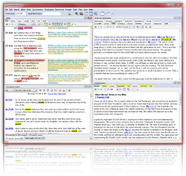Fowl
Fowl
is the rendering of the following Heb. words in the Bible:
1. Usually עוֹŠ (oph, a flier), πετεινόν, any winged animal, a generic term for the feathered race, frequently with the addition of הָּשָּׁמִיַם, "of the heavens."
2. עִיַט (a'yit, so called from rushing on. its prey; compare Jer 12:9, where it is spoken of a beast), a ravenous bird (Job 28:7); as an emblem of a warlike king (Isa 46:11); collect for birds of prey (Ge 15:11; Isa 18:6; Eze 39:4). like ὄρνεον, as a vulture (Re 18:2; Re 19:17,21); translated fowl in Ge 15:11; Job 28:7; Isa 18:6.
3. צַפּור (tsippor', so called from its twittering; Chald. צַפִּר, Da 4:9,11,18,30), a small bird, spec. a sparrow (Ps 84:4; Ps 102:8; Pr 26:2; Pr 27:8; Job 40:24; Ec 12:6, etc.), or similar small birds (Ps 11:1; Ps 104:17; Ps 124:7; as caught by the fowler, Pr 6:5; Pr 7:23; Am 3:5, etc.; also collect. birds of any kind, Ge 15:10;. Le 14:4-53; De 4:17; Ps 8:9; Ps 148:10: etc.; and even a bird of prey, Eze 39:4), occasionally rendered by swallow and sparrow. In Ne 5:18, the word seems to have the special sense which "fowl" has with us, as it is enumerated among the viands provided for Nehemiah's table.
⇒See also the International Standard Bible Encyclopedia.
4. בִּרבֻּרַים (barburim'), "fatted fowls," 1Ki 4:23, as provided for the table of Solomon, where Kimchi understands capons, but Gesenius, with the Jerus. Targum, geese, so called from the pureness and whiteness of their plumage: The ancient Egyptians had spacious poultry-yards, set apart for keeping geese and other wild-fowl, which they fattened for the table; and their poulterers bestowed especial care upon the geese (Wilkinson, 1:215; 2:174, abridgm.). SEE FATTED FOWL.
In the N.T. the word translated "fowls" is most frequently τὰ πετεινά, which comprehends all kinds of birds (including ravens, Lu 12:24).; but in Re 19:17-21, where the context shows that birds of prey are meant, the Greek is τὰ ὄρνεα. The same distinction is observed in thee apocryphal writings: comp. Judith 11:7; Ecclus. 17:4; 43:14, with 2 Macc. 15:33. SEE COCK; SEE SPARROW.
The following statements cover the remaining details. — Clean binds כָּלאּצַפּוֹר טהֹרָח, De 14:11,20), i.e., all not named in Le 11:13-19; De 14:12-18, were (as well as their eggs, בֵּיצַים) used for food (Lu 11:12), e.g. quails (q.v.), chickens, doves, also wild-fowl; hence bird-catching was very common (Ps 124:7; Am 3:5; Ho 5:1; Ho 7:12, etc.), for. which purpose. nets, traps, and stool-birds (Jer 5:27; Ecclus. 11:31 [37]) were used (see Gesen. Thes. page 685). SEE FOWLER. In robbing a nest of its eggs or young, however, "the mother-bird must be allowed to escape (De 22:6 sq.; see Michaelis, Syntagm. Comm. 2, 89 sq.; Mos. Recht, 3:181 sq.), a prescription founded snot only on motives of humanity (comp. Le 22:28; yet see Heumans, De legis div. semnsu, Gott. 1748; also in his Nova Sylloge Dissertatt. page 282 sq.); although the Talmudists (Mishna, Chollin, 12:2) refer this only to clean birds, and make many nice distinctions in the matter, with various penalties attached (Maccoth, 3:4). Birds were not regularly offered in sacrifice, except in commutation for some costlier victim (Le 1:15-17; compare Mishna, Kinnim, 5:11). SEE DOVE. The bird was first brought to the altar, where the priest (with his nail) nipped off the head, or rather cracked (מלק) thee neck, so that it still hung to the bird (Le 5:8); he then squeezed out the blood (sufficient, at least, in quantity for sprinkling), and finally threw the body into the fire, but without the crop, which (with its contents and the offal) was separately (ברל) thrown into the ash-heap under the altar. Before the flesh was committed to the flames, however, a folding back or breaking of the wings (שַׁסִּע בּכנָפָיו) is prescribed, a symbol of which the meaning is not clear (see Dassov, De ave ungue secta, Viteb. 1697; Eskuche, De gall/a et gallisis ad aram Jehovca nonfractisa Rint. 1741). The Talmud mentions geese (אִוָּז, Chol. 12:1; Bekor. 7:4), a well-knows article of luxury with modern Jews. The Hebrews were accustomed to play with parlor-birds, especially children (Job 40:24 [24]; Baruch 3:17; comp. Catull. 2:1 sq.; Plaut. Capt. 5:4, 5). Of that form of divination which draw omens from the appearance or flight of birds (Muller, Etrusk. 2:187 sq.), an example occurs in the history of the Herodian family (Josephus, Ant. 19:8, 2). SEE SOOTHSAYER. Thee fable of the phoenix (Pliny, 10:2; Ovid, Met. 15:392 sq.; comp. Herod. 2:73) is thought by some (also Ewald) to be alluded to in Job 29:18 (see Gesenius, Thes. Heb. page 453 sq.). See generally Tenzel, in the Thesaur. theol. philol. 1:559 sq. Comp. BIRD.

